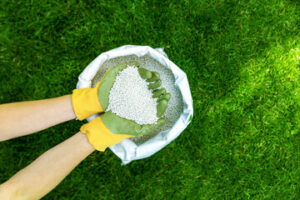Whether you’re a seasoned lawn-care professional or a novice with a brand-new lawn, there are a few things you should know before you start your lawn fertilization. This includes the type of fertilizer you should use, the time of year you should fertilize your lawn, and how long you should expect it to take. 
Getting the right time to fertilize your lawn is important because it gives your grass the nutrients it needs to thrive. The first application should be done in mid-April in most parts of the States. This will help your grass grow strong roots and produce a blooming, green lawn in the spring.
If you live in a cold climate, you should delay fertilizing until the end of fall or early winter. Fertilizing during these months will not provide any benefit to your grass. It may cause discoloration, especially if you overwater your lawn. You can also prevent chemical burns on your roots by diluting your fertilizer.
If you live in a warm climate, you may want to fertilize your lawn in early fall or early spring. The soil temperature is usually low during this time, and this is ideal for your grass to get the nutrients it needs to grow.
When you fertilize your lawn, you should make sure that you use the right type of fertilizer. You should use a fertilizer that has 25%-50% slow-release nitrogen.
Once you have applied your fertilizer, water your lawn lightly to encourage the nutrients to be absorbed. You should start on the outer perimeter of the lawn and work your way backward, using a spreader or your hands. You should water the area to dissolve the fertilizer evenly.
Once you have applied the fertilizer, you should wait 24 hours before playing on your lawn. This is important because the heat of the day can cause the grass to discolor.
Choosing the right lawn fertilizer is an important step to maintaining healthy grass. There are many different types of lawn fertilizers on the market. There are liquid, granular, and slow-release fertilizers. These fertilizers are intended for specific applications.
Choosing the best fertilizer for your lawn depends on a number of factors. The N-P-K ratio, or nutrient concentration, is one of the most important factors to consider. N-P-K numbers are found on the labels of most fertilizers. This number indicates how much nitrogen, phosphorus, and potassium are present in a specific fertilizer. A lack of one of these three nutrients can lead to an imbalance in the soil.
Phosphorus is a key nutrient for plants. It helps strengthen the cell structure and promotes fruit and flower growth. It is also important for photosynthesis, which helps plants grow larger flowers and fruits. Phosphorous-rich fertilizers are especially important for newly-planted lawns.
Quick-release fertilizers are ideal for lawns that need a quick nutrient boost. These fertilizers provide nitrogen immediately. Quick-release fertilizers can last for up to four weeks. However, they should be applied to properly-watered lawns.
Slow-release fertilizers are ideal for lawns with an irrigation system. These fertilizers provide a steady supply of nutrients until the next spring. They are easy to apply and do not burn the grass. Slow-release fertilizers can last for up to twelve weeks.
Organic fertilizers are better for the environment. They are made from natural sources, such as animal excreta and vegetable matter. These fertilizers have a higher nutrient concentration than synthetic options. They are also safer for lawns frequented by pets. However, most people do not have the time or patience to use organic fertilizers.
Generally speaking, slow-release and quick-release lawn fertilization are two different methods of nourishing grass. Each has its own advantages and disadvantages, but you should use a combination of both to best suit your lawn’s needs.
Slow-release fertilizers provide the same nutrients as quick-release fertilizers, but they are released at a slower rate. This means that they offer your grass a steady supply of nutrients over a longer period of time. They are also less likely to burn your lawn, so they are ideal for use on established lawns.
Quick-release fertilizers work by dissolving quickly in the soil. They are ideal for use on newly established lawns, as well as for promoting rapid growth on existing lawns. When used in conjunction with an effective fertilizing program, they can also help a lawn recover from a disease or injury. However, they can also burn your grass if they are used too frequently. If you do decide to use a quick-release fertilizer, it is important to read the instructions for use and apply it correctly.
Quick-release fertilizers are usually manufactured with synthetic nutrients. They are also more likely to be mobile in the soil. These products usually contain potassium, which helps with moisture regulation and photosynthesis.
